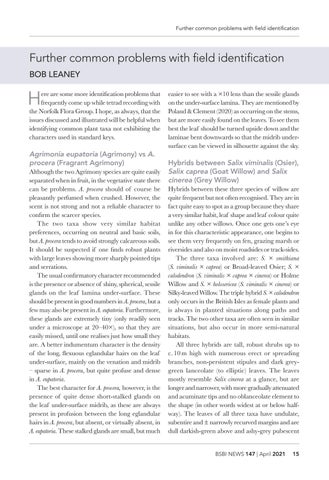Further common problems with field identification
Furthercommonproblemswitheldidentication BOB LEANEY
H
ere are some more identification problems that frequently come up while tetrad recording with the Norfolk Flora Group. I hope, as always, that the issues discussed and illustrated will be helpful when identifying common plant taxa not exhibiting the characters used in standard keys.
Agrimonia eupatoria (Agrimony) vs A. procera (Fragrant Agrimony)
Although the two Agrimony species are quite easily separated when in fruit, in the vegetative state there can be problems. A. procera should of course be pleasantly perfumed when crushed. However, the scent is not strong and not a reliable character to confirm the scarcer species. The two taxa show very similar habitat preferences, occurring on neutral and basic soils, but A. procera tends to avoid strongly calcareous soils. It should be suspected if one finds robust plants with large leaves showing more sharply pointed tips and serrations. The usual confirmatory character recommended is the presence or absence of shiny, spherical, sessile glands on the leaf lamina under-surface. These should be present in good numbers in A. procera, but a few may also be present in A. eupatoria. Furthermore, these glands are extremely tiny (only readily seen under a microscope at 20–40×), so that they are easily missed, until one realises just how small they are. A better indumentum character is the density of the long, flexuous eglandular hairs on the leaf under-surface, mainly on the venation and midrib – sparse in A. procera, but quite profuse and dense in A. eupatoria. The best character for A. procera, however, is the presence of quite dense short-stalked glands on the leaf under-surface midrib, as these are always present in profusion between the long eglandular hairs in A. procera, but absent, or virtually absent, in A. eupatoria. These stalked glands are small, but much
easier to see with a ×10 lens than the sessile glands on the under-surface lamina. They are mentioned by Poland & Clement (2020) as occurring on the stems, but are more easily found on the leaves. To see them best the leaf should be turned upside down and the laminae bent downwards so that the midrib undersurface can be viewed in silhouette against the sky.
Hybrids between Salix viminalis (Osier), Salix caprea (Goat Willow) and Salix cinerea (Grey Willow)
Hybrids between these three species of willow are quite frequent but not often recognised. They are in fact quite easy to spot as a group because they share a very similar habit, leaf shape and leaf colour quite unlike any other willows. Once one gets one’s eye in for this characteristic appearance, one begins to see them very frequently on fen, grazing marsh or riversides and also on moist roadsides or track-sides. The three taxa involved are: S. × smithiana (S. viminalis × caprea) or Broad-leaved Osier; S. × calodendron (S. viminalis × caprea × cinerea) or Holme Willow and S. × holosericea (S. viminalis × cinerea) or Silky-leaved Willow. The triple hybrid S. × calodendron only occurs in the British Isles as female plants and is always in planted situations along paths and tracks. The two other taxa are often seen in similar situations, but also occur in more semi-natural habitats. All three hybrids are tall, robust shrubs up to c. 10 m high with numerous erect or spreading branches, non-persistent stipules and dark greygreen lanceolate (to elliptic) leaves. The leaves mostly resemble Salix cinerea at a glance, but are longer and narrower, with more gradually attenuated and acuminate tips and no oblanceolate element to the shape (in other words widest at or below halfway). The leaves of all three taxa have undulate, subentire and ± narrowly recurved margins and are dull darkish-green above and ashy-grey pubescent BSBI NEWS 147 | April 2021
15
















